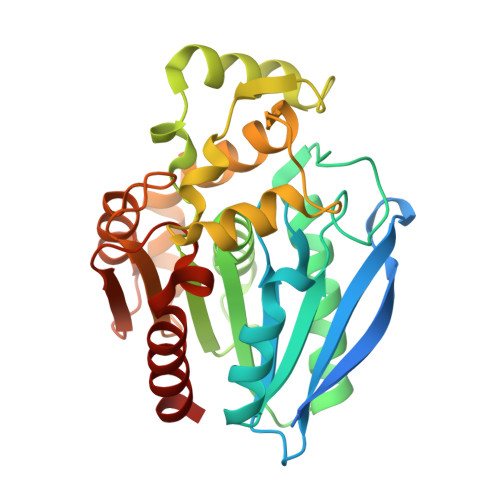Structural Changes in the Cap of Rv0183/mtbMGL Modulate the Shape of the Binding Pocket.
Grininger, C., Leypold, M., Aschauer, P., Pavkov-Keller, T., Riegler-Berket, L., Breinbauer, R., Oberer, M.(2021) Biomolecules 11
- PubMed: 34572512
- DOI: https://doi.org/10.3390/biom11091299
- Primary Citation of Related Structures:
7OZM, 7P0Y - PubMed Abstract:
Tuberculosis continues to be a major threat to the human population. Global efforts to eradicate the disease are ongoing but are hampered by the increasing occurrence of multidrug-resistant strains of Mycobacterium tuberculosis . Therefore, the development of new treatment, and the exploration of new druggable targets and treatment strategies, are of high importance. Rv0183/mtbMGL, is a monoacylglycerol lipase of M. tuberculosis and it is involved in providing fatty acids and glycerol as building blocks and as an energy source. Since the lipase is expressed during the dormant and active phase of an infection, Rv0183/mtbMGL is an interesting target for inhibition. In this work, we determined the crystal structures of a surface-entropy reduced variant K74A Rv0183/mtbMGL in its free form and in complex with a substrate mimicking inhibitor. The two structures reveal conformational changes in the cap region that forms a major part of the substrate/inhibitor binding region. We present a completely closed conformation in the free form and semi-closed conformation in the ligand-bound form. These conformations differ from the previously published, completely open conformation of Rv0183/mtbMGL. Thus, this work demonstrates the high conformational plasticity of the cap from open to closed conformations and provides useful insights into changes in the substrate-binding pocket, the target of potential small-molecule inhibitors.
Organizational Affiliation:
Institute of Molecular Biosciences, University of Graz, 8010 Graz, Austria.















